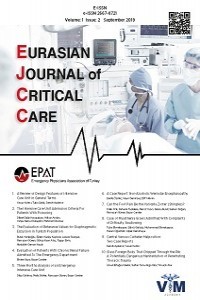Evaluation of Patients Aged 65 and Over After Fall
Evaluation of Patients Aged 65 and Over After Fall
Fall, geriatric trauma, upper extremity injury,
___
- 1- Jacobs DG. Special considerations in geriatric injury. Curr Opin Crit Care 2003; 9:535
- 2- Sterling DA, O'Connor JA, Bonadies J. Geriatric falls: injury severity is high and disproportionate to mechanism. J Trauma 2001; 50:116
- 3- Bergeron E, Clement J, Lavoie A, et al. A simple fall in the elderly: not so simple. J Trauma 2006; 60:268
- 4- Labib N, Nouh T, Winocour S, et al. Severely injured geriatric population: morbidity, mortality, and risk factors. J Trauma 2011; 71:1908
- 5- Callaway DW, Wolfe R. Geriatric trauma. Emerg Med Clin North Am 2007; 25:837
- 6- Henry SM, Pollak AN, Jones AL, et al. Pelvic fracture in geriatric patients: a distinct clinical entity. J Trauma 2002; 53:15
- 7- Kirkpatrick JB, Pearson J. Fatal cerebral injury in the elderly. J Am Geriatr Soc 1978; 26:489
- 8- Goldstein JN, Thomas SH, Frontiero V, et al. Timing of fresh frozen plasma administration and rapid correction of coagulopathy in warfarin-related intracerebral hemorrhage. Stroke 2006; 37:151
- Başlangıç: 2019
- Yayıncı: Acil Tıp Uzmanları Derneği
Evaluation of Patients Aged 65 and Over After Fall
Ayça ÇALBAY, Zeynep GÖKCAN ÇAKIR, Abdullah Osman KOÇAK
A Rare Cause of Spontaneous Pneumomediastinum: High Altitude
Utku Murat KALAFAT, Serkan DOĞAN, Ramiz YAZICI, Bensu BULUT, Duygu YAMAN, Başar CANDER
Can We Predict Mortality in Traffic Accidents in Emergency Department?
Hereditary Angioedema and Allergic Reaction Due to Fresh Frozen Plasma
Şükrü GÜRBÜZ, Muhammed EKMEKYAPAR
Diagnostic Difficulties of Spontaneous Gastric Peforation in Adolescents
Zeliha Akış YILDIZ, Ceyhan ŞAHİN, Mehmet ARPACIK, Hayriye Nihan AYYILDIZ, Aytekin KAYMAKÇI
Management of Congestive Heart Failure and Pulmonary Edema
Eylem KUDAY KAYKISIZ, Ramazan GÜVEN, Burak KATİPOĞLU
Aortic Dissection in Different Clinical Findings : Case Series
Muhammed EKMEKYAPAR, Hakan OĞUZTÜRK, Tuba EKMEKYAPAR, Serdar DERYA, Şükrü GÜRBÜZ, Mehmet Gökhan TURTAY
